4-7. Once again. I think there is only one secure path for us ahead,
viz. to use the days in the Gregorian calendar in combination with the
corresponding nakshatra stars 183 right ascension days later
(or earlier), those stars
which would have been observed in the night.
Two days after the Full Moon ideally ought to have been at the
right ascension line at the
Ghost of Jupiter the Sun would rise
together with Homan (*341.2) in day 421 when the Full
Moon should be visible close to the right ascension line of
Shir (*158.9).
The 4th Son behind the King (→
Possessing Luminous Rays,
ρ Leonis, Shir) was
on the ecliptic way of the Sun downwards:
... Resh (Arabic: rāۥ)
is the twentieth letter of many Semitic alphabets,
including Phoenician, Aramaic, Hebrew ... The word
resh is usually assumed to have come from a
pictogram of a head, ultimately reflecting
Proto-Semitic *raۥ(i)š-.
The word's East Semitic cognate, rēš-, was
one possible phonetic reading of the Sumerian
cuneiform sign for 'head' (SAG)
...
... Marija Gimbutas: 'To sleep within the Goddess's
womb was to die and to come to life anew'. In a
system of reincarnation the old one must die in
order to be reborn, of course. At midsummer Sun
comes to a standstill, and this must therefore be an
occasion when the 'flame of life' had to be
transported into a new body ...


|
8 * 29½ = 236 =
472 / 2 and 236 - 81 = *155 (AL-GIEBA, γ Leonis)
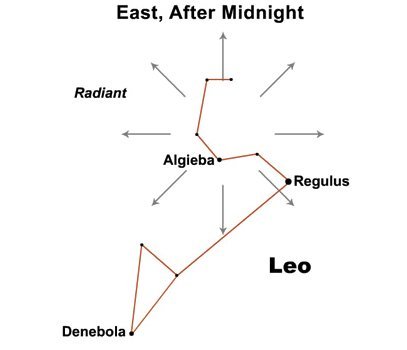 |
|
Febr 22
(236 - 183 = 53) |
23 (→
Terminalia) |
24 (421) |
CASTOR (α Gemini) |
PROCYON (α Canis Minoris) |
HOMAN
(*341.2) |
 |
 |
 |
|
Ea4-2 |
Ea4-3 |
Ea4-4 (104) |
|
marama |
tagata moe - marama |
kua
oho - vai taketake |
|
GHOST OF
JUPITER (*156.8) |
μ
Hydrae
(*157.1) |
SHIR (*158.9) |
|
... among the many Polynesian
names of Jupiter there was
Homan-alonalo, Jupiter (Father Light, Jus-piter) as
morning star ...
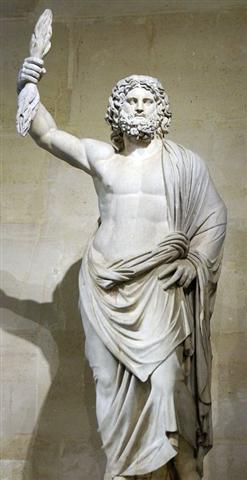 |
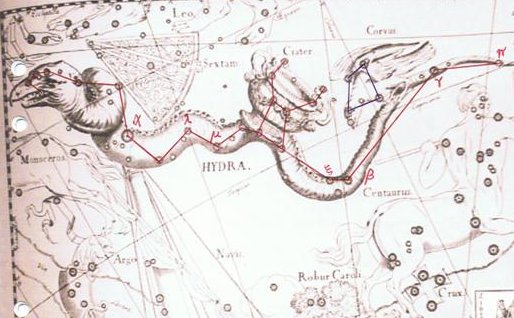
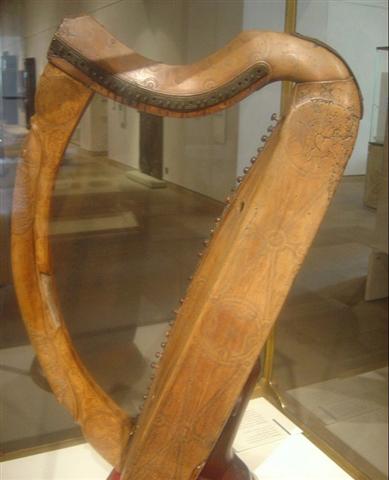 |
According to the Gregorian calendar there was no leap day in
February 25. And Bissextum was a phenomenon in Roman
times.
|
Febr 22
(236 - 183) |
23 (→
Terminalia) |
24 (420) |
25 (136 - 80) |
26 |
27 |
|
→
INVISIBLY CLOSE TO THE SUN: |
|
Al Sa'ad al Ahbiyah-23
(Lucky Star of Hidden Things)
/
Shatabisha-25
(Comprising a Hundred Physicians)
ε
Oct. (338.1),
ρ
Aquarii
(338.2), 2/365 Lac. (338.5),
SADACHBIA =
γ
Aquarii
(338.6),
π
Gruis (338.9) |
β/172
Lac. (339.2),
4/1100 Lac. (339.4),
π
Aquarii
(339.5)
*298.0 = *339.4 - *41.4
CASTOR (α Gemini) |
δ Tucanae (340.1), ρ Cephei (340.2), ν Gruis
(340.3),
ζ Aquarii, δ Gruis (340.4), 5/1100 Lac. (340.7), σ Aquarii, 6/650 Lac. (340.9)
*299.0 = *340.4 - *41.4
PROCYON (α Canis Minoris) |
υ
Oct. (341.0), α/91 Lac. (341.1),
HOMAN = ζ
Pegasi,
β Piscis Austrini (341.2), ν Tucanae (341.5), υ
Aquarii (341.9) |
η Aquarii (342.1), σ Gruis (342.4),
SITULA (Water-jar) = κ Aquarii
(342.7)
*301.0 = *342.4 - *41.4 |
ε
Piscis Austrini (343.5), ο Pegasi, β Gruis
(343.8) |
|
... γ,
4.1, greenish, on the right arm at the inner
edge of the Urn, and the westernmost star in the
Y, is Sadachbia, from Al Sa'd al
Ahbiyah, which has been interpreted the
Lucky Star of Hidden Things or Hiding-places,
because when it emerged from the sun's rays all
hidden worms and reptiles, buried during the
preceding cold, creep out of their holes! But as
this word Ah Biyah is merely the plural
of Hibā', a Tent, a more reasonable
explanation is that the star was so called from
its rising in the
spring twilight, when, after the winter's want
and suffering, the nomads' tents were raised on
the freshening pastures, and the pleasent
weather set in. This
idea renders Professor Whitney's 'Felicity of
Tents' a happy translation of the original ...
... Zeta
(uppercase Ζ,
lowercase ζ; Greek:
ζήτα
... is the sixth letter of the Greek alphabet.
In the system of Greek numerals, it has a value
of 7. It was derived from the Phoenician letter
Zayin. Letters that arose from zeta
include the Roman Z and Cyrillic З
...Zayin
(also spelled Zain or Zayn or
simply Zay) is the seventh letter of many
Semitic abjads ... It represents the sound
[z]. The Phoenician
letter appears to be named after a sword or
other weapon. (In Biblical Hebrew, 'Zayin'
means sword, and the verb 'Lezayen' means
to arm. In modern Hebrew, 'zayin' means
penis and 'lezayen' is a vulgar term
which generally means to perform sexual
intercourse and is used in a similar fashion to
the English word fuck, although the older
meaning survives in 'maavak mezuyan'
(armed struggle) and 'beton mezuyan'
(armed, i.e., reinforced concrete). The
Proto-Sinaitic glyph according to Brian Colless
may have been called ziqq, based on a
hieroglyph depicting a 'manacle' ...

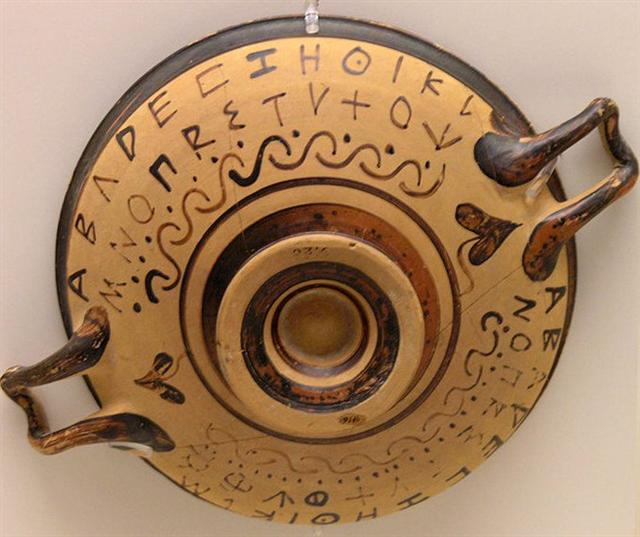
... Kaph is thought to have been derived
from a pictogram of a hand (in both modern
Arabic and modern Hebrew, kaph means
palm/grip) ... The manik,
with the tzab, or serpent's rattles as
prefix, runs across Madrid tz. 22 , the figures
in the pictures all holding the rattle; it runs
across the hunting scenes of Madrid tz. 61, 62,
and finally appears in all four clauses of tz.
175, the so-called 'baptism' tzolkin. It seems
impossible, with all this, to avoid assigning
the value of grasping or receiving. But in the
final confirmation, we have the direct evidence
of the signs for East and West. For the East we
have the glyph Ahau-Kin, the Lord Sun,
the Lord of Day; for the West we have
Manik-Kin, exactly corresponding to the term
Chikin, the biting or eating of the Sun,
seizing it in the mouth.



The pictures (from Gates) show
east, north, west, and south; respectively (the
lower two glyphs) 'Lord' (Ahau) and
'grasp' (Manik). Manik was the 7th
day sign of the 20 and Ahau the last ... |
 |
 |
 |
 |
 |
 |
|
Ea4-1 →
Bharani |
Ea4-2 |
Ea4-3 |
Ea4-4 (104) |
Ea4-5 |
Ea4-6 |
|
Tagata moe |
marama |
tagata moe - marama |
kua
oho - vai taketake |
te
hokohuki - moa ia |
hokohuki |
|
Take. The Marquesans are the only
people who own to a distinctive national name,
and retain a tradition of the road they
travelled from their original habitat, until
they arrived at the Marquesan Islands. They call
themselves te Take, 'the Take
nation'. Fornander. Take, Tuvaluan for
the Black Noddy (Anous Minutes). The
specific epithet taketake is Māori for
long established, ancient, or original. In the
Rapa Nui mythology, the deity
Make-make was the chief god of the birdman
cult, the other three gods associated with it
being Hawa-tuu-take-take (the Chief of
the eggs) his wife Vie Hoa and Vie
Kanatea. Wikipedia.
... When it was evident that
the years lay ready to burst into life, everyone
took hold of them, so that once more would start
forth - once again - another (period of)
fifty-two years. Then
(the two cycles) might proceed to reach one
hundred and four years. It was called 'One Age'
when twice they had made the round, when twice
the times of binding the years had come
together. Behold what was done when the years
were bound - when was reached the time when they
were to draw the new fire, when now its count
was accomplished. First they put out fires
everywhere in the country round. And the
statues, hewn in either wood or stone, kept in
each man's home and regarded as gods, were all
cast into the water.
Also (were) these (cast away) - the pestles and
the (three) hearth stones (upon which the
cooking pots rested); and everywhere there was
much sweeping - there was sweeping very clear.
Rubbish was thrown out; none lay in any of the
houses
...
... In the
present context 'mouth' has an additional
connotation, given that it refers in part to
Heart of Earth, the deity called 'Mundo'
today. This is the great Mesoamerican earth
deity, the ultimate swallower of all living
beings, depicted in Classic Mayan art (in the
Palenque relief panels, for example) as an
enormous pair of jaws upon whose lips even the
feet of great lords must rest in precarious
balance, and into whose throat even great lords
must fall. Turning to the contemporary scene,
daykeepers who visit the main cave beneath the
ruins of Rotten Cane,
the last Quiché capital, speak of the danger of
falling into 'the open mouth of the Mundo'
there, which is said to be more than four yards
wide
...
... A crack
opened up in the ground, and the Rat was put
down into the pit, to rest there - he
hakatopa i te kioe.ki raro ki te rua.he hakarere
... [E:
Tori 4]
...
Interestingly, since another meaning of shi
is 'death', the number 4 is considered unlucky.
For example, the floor numbering in
hotels sometimes jumps
mysteriously from 3 to 5; it's also considered
unlucky to give four of something as a present
...
|
Counting the tresses from
right to left: |
|
1 |
26 |
78 |
1 |
29 |
90 |
|
2 |
26 |
2 |
30 |
|
3 |
26 |
3 |
31 |
|
4 |
25 |
104 |
4 |
34 |
124 |
|
5 |
26 |
5 |
31 |
|
6 |
27 |
6 |
30 |
|
7 |
26 |
7 |
29 |
|
Total = 182 + 214 = 396
|
|
|
VISIBLE
CLOSE TO THE FULL MOON: |
|
ALGIEBA (The Mane) =
γ
Leonis,
q Carinae (155.5) |
TANIA AUSTRALIS (Southern Gazelle) =
μ
Ursae Majoris
(156.0),
GHOST OF JUPITER = NGC3242 Hydrae
(156.8) |
Extended Net-26b (Ox)
μ
Hydrae
(157.1) |
Maru-sha-arkat-Sharru-15 (4th Son behind the
King)
SHIR (Possessing Luminous Rays) =
ρ
Leonis
(158.9) |
p Carinae (159.3) |
φ Hydrae (160.3) |
|
ALCYONE (136) |
*100 |
TANIA AUSTRALIS (236) |
|
May 16 (*56) |
Aug 24 (*156) |
|
σ Virginis (280 = 136 + 64 + 80) |
*100 |
ALTAIR (380 = 136 + 236 + 8) |
|
AUG 4 (*136) |
NOV 12 (*236) |
|
... It was 4 August 1968, and it was the feast day of Saint
Dominic, patron of Santo Domingo Pueblo, southwest of Santa Fe.
At one end of the hot, dusty plaza, a Dominican priest watched
nervously as several hundred dancers arranged in two long rows
pounded the earth with their moccasined feet as a mighty,
collective prayer [ui] for rain, accompanied by the
powerful baritone singing of a chorus and the beat of drums. As
my family and I viewed this, the largest and in some ways the
most impressive Native American public ceremony, a tiny cloud
over the Jémez Mountains to the northwest got larger and larger,
eventually filling up the sky; at last the storm broke, and the
sky was crisscrossed by lightning and the pueblo resounded with
peals of rolling thunder ...
 |
|
|
Aug 23 (235) |
24 (8 * 29½) |
25 (420 - 183) |
26 |
27 |
28 (240) |
As if by chance - (cfr February 24, 421 and Ea4-21) - the
number of glyphs on side a of the B tablet was determined to
be 421.
Now, let's carry on!
|
Febr 28
(424) |
March 1 |
2 (61) |
3 |
4 |
5 |
6 (65) |
7 |
 |
 |
 |
 |
 |
 |
 |
 |
|
Ea4-7 |
Ea4-8 (108) |
Ea4-9 |
4-10 |
Ea4-11 |
Ea4-12 |
Ea4-13 |
4-14 |
|
kua te ariki - te hau tea |
te kihikihi |
henua huri hia |
te raa |
manu rere |
kua moe |
te ua - te ragi |
e inoino - marama - ragi |
|
Huri. 1. To turn
(vt.), to overthrow, to knock
down: huri moai, the overthrowing of the
statues from their ahus during the period
of decadence on the island. 2. To pour a
liquid from a container: ka huri mai te vai,
pour me some water. 3. To end a lament, a
mourning: he huri i te tagi, ina ekó tagi
hakaou, with this the mourning (for the
deceased) is over, there shall be no more
crying. 4. New shoot of banana: huri
maîka. Vanaga. 1. Stem. P Mgv.: huri,
a banana shoot. Mq.: hui, shoot, scion.
2. To turn over, to be turned over onto another
side, to bend, to lean, to warp; huri ke,
to change, to decant; tae huri ke,
invariable; huri ke tahaga no mai, to
change as the wind; tae huri, immovable;
e ko huri ke, infallible; huhuri,
rolling; hakahuri, to turn over;
hakahuri ke, to divine. P Pau.: huri,
to turn. Mgv.: huri, uri, to turn
on one side, to roll, to turn upside down, to
reverse. Mq.: hui, to turn, to reverse.
3. To throw, to shoot. 4. To water, to wet. 5.
To hollow out. Hurihuri: 1. Wrath, anger;
kokoma hurihuri, animosity, spite, wrath,
fury, hate, enmity, irritable, quick tempered,
to feel offended, to resent, to pester;
kokoma hurihuri ke, to be in a rage. 2. (huri
4) hurihuri titi, to fill up. 3. To
polish. 4. (uriuri). Hurikea, to
transfigure, to transform. Churchill. Mq.
huri, resemblance. Sa.: foliga, to
resemble. Churchill. |
|
March 8 |
9 |
10 (*354) |
11 |
12 |
13 |
3-14 |
15
→ Idus |
 |
 |
 |
 |
 |
 |
 |
 |
|
Ea4-15 |
Ea4-16 |
Ea4-17 |
Ea4-18 |
Ea4-19 |
4-20 |
Ea4-21 |
Ea4-22 (122) |
|
inoino - ragi |
te vaha mea |
ki haga o rave hia |
te vaha |
te rima |
te ua |
te hokohuki - kiore kikiu |
hokohuki - koia ra - ku kikiu |
|
Rave.
Ta.: Rave, to take. Sa.:
lavea, to be removed, of a disease. To.:
lavea, to bite, to take the hook, as a fish.
Fu.: lave, to comprehend, to seize. Niuē:
laveaki,
to convey. Rar.: rave,
to take, to receive. Mgv: rave,
to take, to take hold; raveika,
fisherman. Ma.: rawe,
to take up, to snatch. Ha.: lawe,
to take and carry in the hand. Mq.:
ave, an
expression used when the fishing line is caught
in the stones. Churchill 2.
Hoki.
To return, to go back, to come back; ka hoki
ki rá, go back there! ana oho koe ki
Hiva, e hoki mai ki nei, if you go to the
mainland, do come back here again. Vanaga. 1.
Also, what; ki ra hoki, precisely there;
pei ra hoki, similitude, likeness; pei
ra hoki ta matou, usage. P Pau.: hokihoki,
often. Mgv.: hoki, also, and, likewise.
Mq.: hoi, surely. Ta.: hoi, also,
likewise. 2. To return, to turn back, to draw
back, to give back, to tack; mau e hoki mai,
to lend; hoki hakahou, to carry back;
hoki amuri, to retrograde; hakahoki,
to bring back, to send back, to carry back, to
restore, to renew, to revoke, to remove, to
dismiss, to pay, to pardon, to compress;
hakahokia, given up; hakahokihaga,
obligation. P Pau.: hokihoki, to persist,
to insist; fakahoki, to give back. Mgv.:
hoki, to return, to retrace one's steps;
oki, to return, to come back. Ta.: hoi,
to return, to come back. Ta.: mahoi, the
essence or soul of a god.
Churchill.
Ko.
1. Article (ko te); preposition: with
(see grammar); prefix of personal pronouns:
koau, I; kokoe, you (singular);
koîa, he, she, it; kokorua, you
(plural); ko tagi, koîa, he with his
weeping. 2. Article which precedes proper nouns,
often also used with place names: Ko Tori, Ko
Hotu Matu'a, Ko Pú. Koîa, exact:
tita'a koîa, exact demarcation. Seems to be
the personal pronoun koîa - applied in
the meaning of: thus it is, here it is
precisely. Vanaga. 1. Negative; e ko,
not, except; e ko ora, incurable; ina
ko, not; ina ko tikea, unseen; ina
e ko, not; ina e ko mou, incessant.
2. A particle used before nouns and pronouns;
ko vau, I; ko te, this; ko mea
tera, this; ati ko peka, to avenge,
ko mua, first, at first, formerly. 3.
There, yonder. P Mgv.: ko, over there,
yonder. Ta.: ó, there, here.
Churchill.
Kikiu.
1. Said of food insufficiently cooked and
therefore tough: kai kikiu. 2. To tie
securely; to tighten the knots of a snare:
ku-kikiu-á te hereíga, the knot has been
tightened. 3. Figuratively: mean, tight, stingy;
puoko kikiu. a miser; also: eve kikiu.
4. To squeak (of rats, chickens). Kiukiu,
to chirp (of chicks and birds); to make short
noises. The first bells brought by the
missionaries were given this name. Vanaga.
Kiukiu (kikiu). 1. To resound, to
ring, sonorous, bell, bronze; kiukiu rikiriki,
hand bell; tagi kiukiu, sound of a bell;
kikiu, to ring, the squeeking of rats;
tariga kikiu, din, buzzing; hakakiukiu,
to ring. Mgv.: kiukiu, a thin sound, a
soft sweet sound. 2. To disobey, disobedience;
mogugu kiukiu, ungrateful; ka kikiu ro,
to importune.
Churchill.
... I became
interested in what really happened at March 15
and reopened Henrikson to find out: Caesar was
forewarned of the threat by the prophet
Spurinna, who told him that a great threat was
coming at Idus Martiae or just
before. The day arrived and Caesar was still
living. He was walking to his meeting with the
Senate when he happened to encounter Spurinna
and told him jokingly that he was still alive.
Spurinna calmely answered that the day had yet
not ended. The Romans divided their months in
two parts and the dividing point was Idus,
which in some way was connected with full moon.
March 15 was the midpoint of March, which is
close to spring equinox. The old agricultural
year defined the beginning of the year to the
time when sun returned, and it was connected
with Mars
...
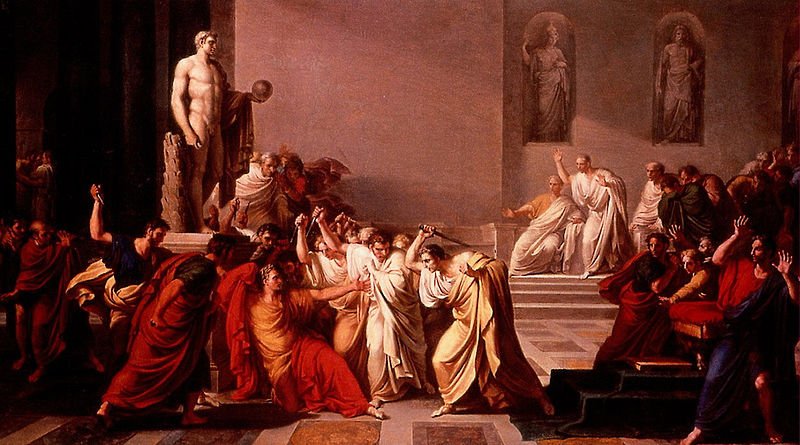 |
36 glyphs were placed in line Ea4. And 36 - (Ea4-)22 (→ π) = 14 (→
Ea4-14 → Bharani → April 14 → 104).
And 60 (Ea4-8
→ 32) +14 = 74 (March
15, Idus) + 14 = 88 (March
29).→ Schedir (the Breast of
Cassiopeia) with the Full Moon ideally at
Porrima.
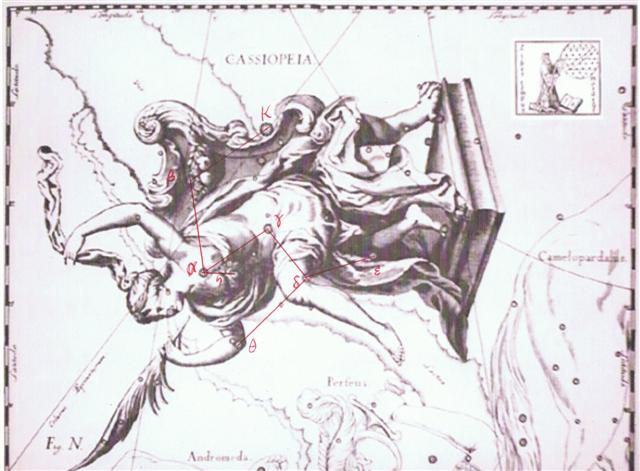
At Ea5-1, in the following day
(March 30), the Full Moon should be at Mimosa (β in
the Southern Cross)
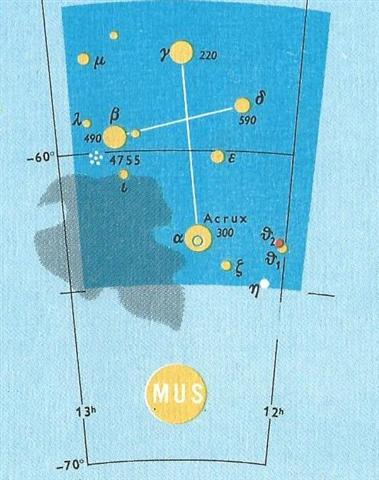
at the time when the Sun would
rise from the Belly of the Sea Beast (Deneb Kaitos, β
Ceti):

Also the Sombrero Galaxy (M104, cfr Ea4-4) was in the
Virgo constellation, in the same right ascension day as
Porrima:


|
.jpg)


























